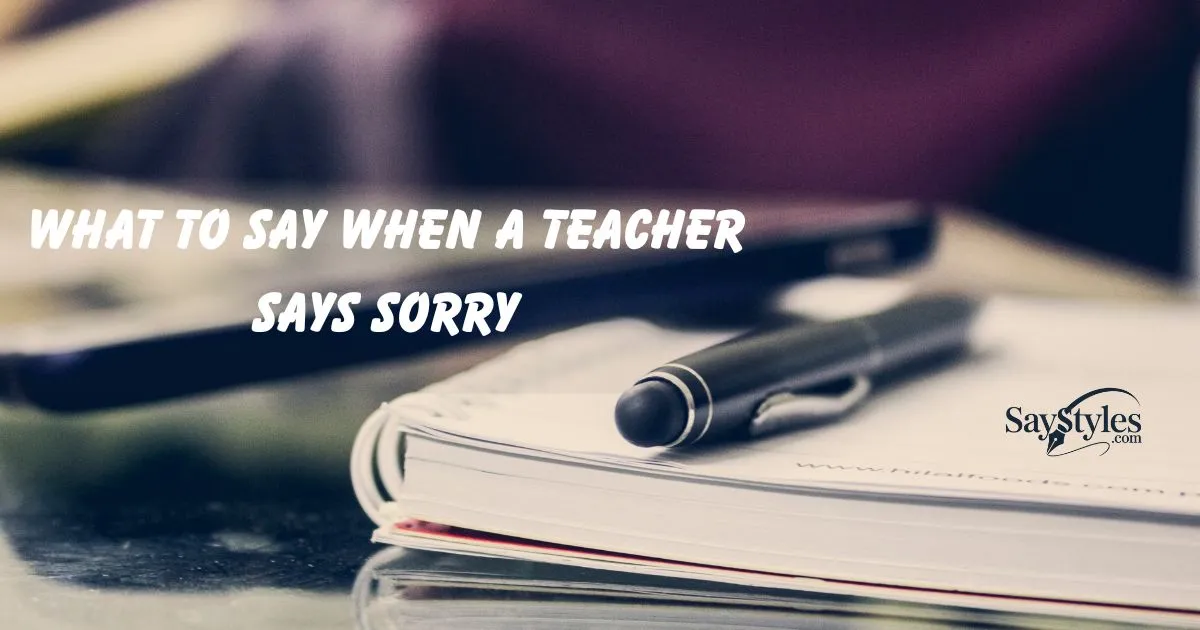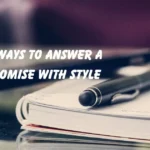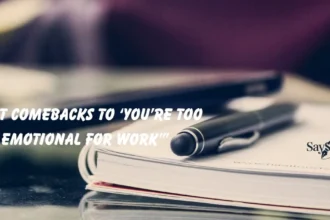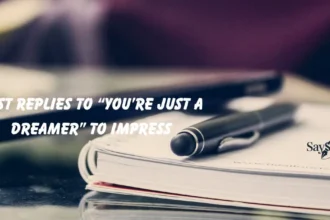Even a great teacher can make a mistake what truly matters is how they apologize and how we respond.
It’s not every day that a teacher says, I’m sorry. When it happens, it can be an unexpected moment that leaves you caught off guard. Maybe it’s about a missed assignment, a misunderstanding, or a simple oversight. No matter the issue, the way you handle the situation can shape your relationship with them moving forward.
In this article, we’ll explore the best ways to reply when a teacher apologizes, how to set the right tone, and why showing grace and clarity in these interactions can make all the difference in your class and beyond.
What Does It Mean When a Teacher Says Sorry?
When a teacher says sorry, it means they recognize a mistake, oversight, or misunderstanding and want to make things right. This could be about a missed assignment, an unfair grading issue, or even a classroom rule that wasn’t clearly explained. It’s an unexpected moment that might leave students caught off guard, but it also shows that the teacher values honesty and respects their students.
Apologizing in a class setting helps build a stronger relationship between students and teachers. It sets a positive tone for learning, encourages open communication, and teaches the importance of grace and clarity when handling tough situations.
1. Thank you for acknowledging that. I appreciate it.
Story: Sarah was expecting feedback on her project, but her teacher forgot to check it. The next day, the teacher apologizes for the oversight and promises to review it.
When to Use: This is best when the teacher admits a mistake and takes responsibility. It shows gratitude and keeps the interaction respectful.
When Not to Use: Avoid this if the issue is unresolved or if the teacher’s apology feels insincere.
Example:
Teacher: I’m sorry, Sarah, I forgot to grade your project.
Sarah: Thank you for acknowledging that. I appreciate it.
How to Respond 🗣️ Show understanding with a smile or nod. Keep the tone friendly to maintain a good relationship.
2. I understand, thank you for letting me know.
Story: James expected a test on Friday, but the teacher had to reschedule. The teacher apologizes for the last-minute change.
When to Use: When a teacher shares an update about a class change or a small mistake that doesn’t need further discussion.
When Not to Use: If the issue affects your grades or requires more explanation.
Example:
Teacher: James, I’m sorry, but the test is moved to next week.
James: I understand, thank you for letting me know.
How to Respond 🗣️ Stay calm and acknowledge the update. If needed, ask for clarification politely.
3. No problem, we all make mistakes.
Story: Lisa’s teacher accidentally marked her answer wrong on a quiz. The teacher quickly apologizes and corrects it.
When to Use: When the teacher’s mistake is small and easily fixed. It helps create a positive class environment.
When Not to Use: If the mistake caused serious confusion or stress, a more detailed conversation may be better.
Example:
Teacher: Lisa, I marked your answer wrong by mistake. I’ll fix it now.
Lisa: No problem, we all make mistakes.
How to Respond 🗣️ Keep the response lighthearted to maintain a good relationship with your teacher.
4. Thank you for apologizing. It means a lot.
Story: David was unfairly called out for talking in class, but it was actually someone else. The next day, the teacher apologizes.
When to Use: When the teacher takes the time to address a misunderstanding and genuinely regrets it.
When Not to Use: If the teacher doesn’t seem sincere or if the issue still needs to be fixed.
Example:
Teacher: David, I’m sorry for assuming you were talking yesterday.
David: Thank you for apologizing. It means a lot.
How to Respond 🗣️ Show appreciation and move on. This keeps the tone positive.
5. I appreciate your honesty. Let’s move on.
Story: Mia’s teacher gave the wrong instructions for a homework assignment. The next day, they apologize and clear up the misunderstanding.
When to Use: When a teacher admits their mistake and the situation is already corrected.
When Not to Use: If you need more clarification before moving forward.
Example:
Teacher: Mia, I gave the wrong instructions for the assignment. I’m sorry for the confusion.
Mia: I appreciate your honesty. Let’s move on.
How to Respond 🗣️ Keep the interaction simple and focus on what comes next.
6. Thank you for addressing this. How can we fix it?
Story: Noah’s teacher lost his test paper and apologizes. He wants to make sure his grades are not affected.
When to Use: When a teacher admits a problem but hasn’t yet offered a solution.
When Not to Use: If the issue is minor and doesn’t require further discussion.
Example:
Teacher: Noah, I misplaced your test paper. I’m sorry for the oversight.
Noah: Thank you for addressing this. How can we fix it?
How to Respond 🗣️ Stay calm and ask for a resolution while keeping a respectful tone.
7. I’m glad you brought this up. Can we talk about it more?
Story: Emily’s teacher graded her essay unfairly. The teacher later apologizes but doesn’t explain why it happened.
When to Use: When you need more information about the issue and want to discuss it further.
When Not to Use: If the teacher’s apology already covers everything.
Example:
Teacher: Emily, I misjudged your essay grade. I should have looked at it more carefully.
Emily: I’m glad you brought this up. Can we talk about it more?
How to Respond 🗣️ Ask politely for clarification and work toward a fair solution.
8. I appreciate your apology. Can we find a solution together?
Story: Mark’s teacher accidentally skipped his name when calling on students for presentations. The teacher apologizes, but Mark still wants his chance.
When to Use: When you accept the apology but need a way to fix the issue.
When Not to Use: If the problem has already been resolved or is too minor to revisit.
Example:
Teacher: Mark, I’m sorry I skipped your turn for the presentation.
Mark: I appreciate your apology. Can we find a solution together?
How to Respond 🗣️ Express gratitude and suggest a way to fix the mistake.
9. Thank you for making things right. I feel better now.
Story: Olivia’s teacher incorrectly gave her a lower grade but later apologizes and fixes it.
When to Use: When the teacher not only says sorry but also corrects the issue.
When Not to Use: If you still feel the issue isn’t fully resolved.
Example:
Teacher: Olivia, I miscalculated your grade. I’ve corrected it now.
Olivia: Thank you for making things right. I feel better now.
How to Respond 🗣️ Acknowledge the effort and move forward with a positive tone.
10. I understand that mistakes happen. Thank you for addressing this.
Story: Ethan’s teacher forgot to upload the homework instructions. The next day, the teacher apologizes and provides the details.
When to Use: When the teacher corrects a mistake and ensures it won’t happen again.
When Not to Use: If the problem is recurring and continues to cause issues.
Example:
Teacher: Ethan, I forgot to post the homework instructions. I’m really sorry about that.
Ethan: I understand that mistakes happen. Thank you for addressing this.
How to Respond 🗣️ Show understanding and move forward positively.
11. I appreciate your sincerity. Let’s focus on moving forward.
Story: Sophia’s teacher forgot to return the graded assignments on time. The teacher apologizes and promises to return them soon.
When to Use: When a teacher genuinely acknowledges a mistake and shows effort to fix it.
When Not to Use: If you need more details or an immediate solution.
Example:
Teacher: Sophia, I’m sorry for the delay in returning your assignments.
Sophia: I appreciate your sincerity. Let’s focus on moving forward.
How to Respond 🗣️ Accept the apology and shift focus to the next steps.
12. That means a lot. I respect your honesty.
Story: Lucas’s teacher accidentally blamed him for disrupting the class, but later realized it was someone else. The teacher apologizes sincerely.
When to Use: When a teacher admits a wrongful assumption and genuinely wants to make things right.
When Not to Use: If the apology feels forced or if the issue caused significant distress.
Example:
Teacher: Lucas, I mistakenly thought you were talking in class. I’m really sorry.
Lucas: That means a lot. I respect your honesty.
How to Respond 🗣️ Keep the conversation respectful and express gratitude.
13. Mistakes happen. I trust it won’t happen again.
Story: Ava’s teacher forgot to update her attendance, marking her absent by mistake. The teacher apologizes and corrects it.
When to Use: When a teacher makes a small error but ensures it won’t happen again.
When Not to Use: If the same mistake keeps happening and affects your grades or records.
Example:
Teacher: Ava, I mistakenly marked you absent. I’ve fixed it now.
Ava: Mistakes happen. I trust it won’t happen again.
How to Respond 🗣️ Stay positive and trust that the issue is resolved.
14. I see you’re taking responsibility. Thank you.
Story: Dylan’s teacher miscalculated his test score. The teacher later realizes the error, apologizes, and corrects it.
When to Use: When a teacher takes full responsibility for a mistake and works to fix it.
When Not to Use: If the apology seems insincere or lacks a clear resolution.
Example:
Teacher: Dylan, I miscalculated your score. I sincerely apologize for the mistake.
Dylan: I see you’re taking responsibility. Thank you.
How to Respond 🗣️ Acknowledge their effort and move forward.
15. I value your apology. Let’s make sure this improves.
Story: Ella’s teacher kept interrupting her during a class discussion and later apologizes for not letting her speak fully.
When to Use: When a teacher apologizes for their behavior and you want to encourage positive change.
When Not to Use: If the issue is minor or already resolved.
Example:
Teacher: Ella, I realized I kept interrupting you during the discussion. I’m sorry.
Ella: I value your apology. Let’s make sure this improves.
How to Respond 🗣️ Appreciate their honesty and promote a better learning environment.
Hilarious Ways to Reply to “What Would I Do Without You?”
Top Editor’s Choice Responses When a Teacher Says Sorry
- Thank you for acknowledging that. I appreciate it.
- I understand, thank you for letting me know.
- No problem, we all make mistakes.
- Thank you for apologizing. It means a lot.
- I appreciate your honesty. Let’s move on.
- Thank you for addressing this. How can we fix it?
- I’m glad you brought this up. Can we talk about it more?
- I appreciate your apology. Can we find a solution together?
- Thank you for making things right. I feel better now.
- I understand that mistakes happen. Thank you for addressing this.
- I appreciate your sincerity. Let’s focus on moving forward.
- That means a lot. I respect your honesty.
- Mistakes happen. I trust it won’t happen again.
- I see you’re taking responsibility. Thank you.
- I value your apology. Let’s make sure this improves.
- It’s okay. I know you didn’t mean to.
- Thank you for recognizing that. I respect that a lot.
- Your honesty is appreciated. Let’s keep learning from it.
- I accept your apology. Let’s focus on what’s next.
- No worries, I understand. Let’s move forward together.
Conclusion
In conclusion, when a teacher says “sorry,” it presents an opportunity to handle the situation with grace and clarity. Responding thoughtfully can help maintain a positive relationship moving forward. Whether it’s an apology for a mistake, an oversight, or a misunderstanding, how you choose to respond plays a crucial role in how both you and your teacher feel about the interaction.
By acknowledging the apology, expressing understanding, and focusing on solutions, you not only show maturity but also set the tone for constructive interactions. The key is to stay calm, empathetic, and forward-thinking, turning any unexpected moment into a chance to build mutual respect.

I’m Lily Hart, the Admin behind the engaging responses at SayStyles.com! With a knack for blending wit and warmth, I turn every piece of writing into something memorable. From clever advice to fun comebacks, I’m here to make sure every response leaves you smiling and thinking.






